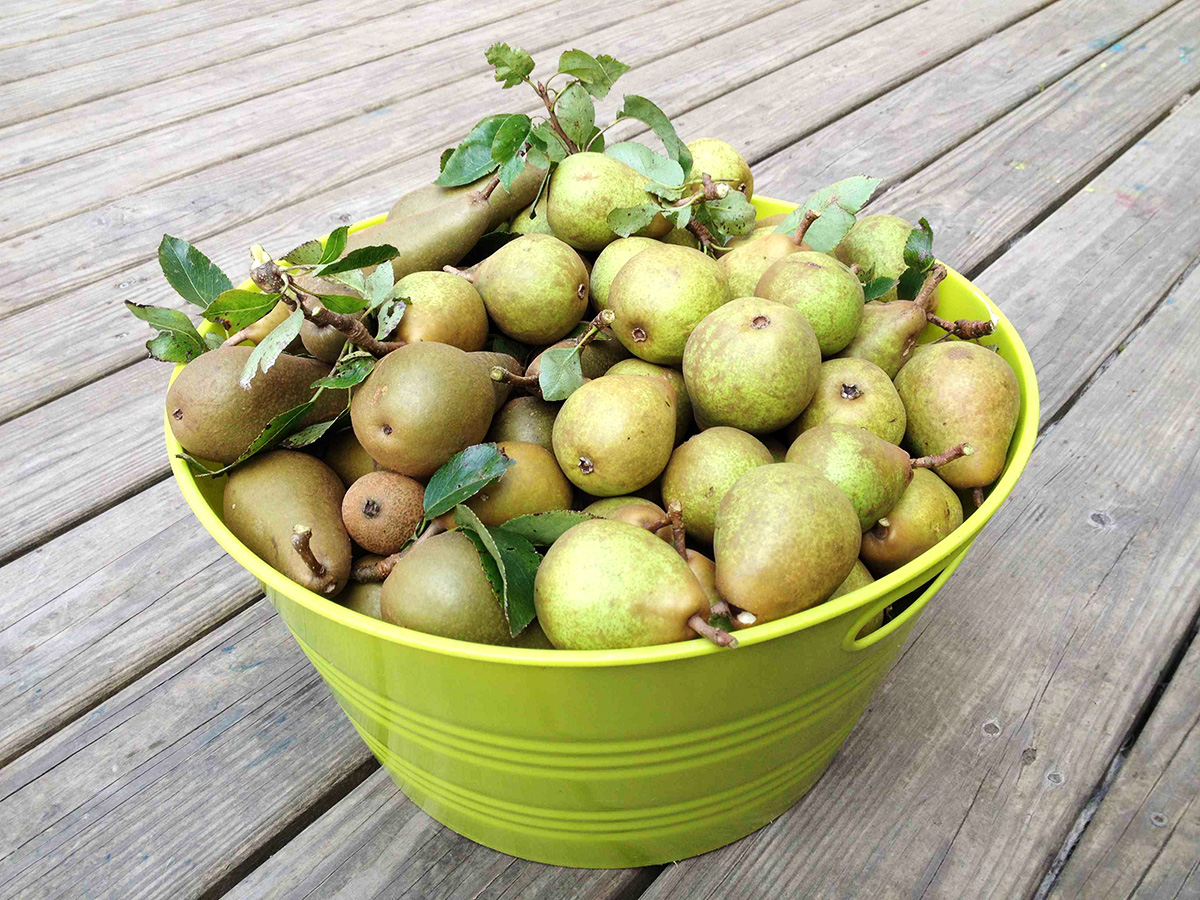This week I spent some time at either end of the food growing cycle: at one end, up to my neck in compost, turning the heaps at the end of the garden; at the other, up to my neck in a mountain of pears in the kitchen, turning them in to a pickle for the winter larder. When it comes down to it, you have to be willing to invest time at both ends of the cycle, if your food growing is to thrive.
Turning compost heaps is unsung, hard bloody work, and not particularly glamorous it has to be said. But, it’s a vital beginning and end to everything that happens in the veg patch. Spent vegetable plants and the rich manure-covered straw from the hen house are barrowed to the compost corner, and with the help of Father Time (and some back-breaking labour) magically turn in to crumbly black gold which is given back to the veg patch soil. I find it immensely comforting to be part of this virtuous circle and increasingly view my role in the veg patch as nutrient shepherd—helping nutrients to flow around the garden between soil, plants, animal and man.
At the other end of the cycle, there are food gluts to deal with. At this time of the year I find these great autumn processing tasks towering over me, tapping their fingers expectantly. Every day as I went down to the end of the garden to feed hens or collect eggs, I was conscious that the pear trees were literally creaking under the weight of pears (a mature pear tree can yield 50–100kg of pears). If they were not to be wasted, a serious marathon of peeling, chopping and general sweating over a hot stove was required. It took me three early-morning hours to convert nearly 10kg of pears in to a pickle (see recipe below)—I’d like to say there’s great joy in this simple labour, but really I would have preferred a lie-in. There is however, a quiet satisfaction to be had in surveying a row of kiln jars and knowing that nature’s great bounty has been harnessed yet again for the winter.
Things to do this September
To-Do
Lift crops which have finished growing and dress bare soil with manure, compost (or plant green manures). Wasps can be problematic as fruit ripens so make traps from jars of sugary water. Remove surplus leaves from tomato plants which allows air to circulate and sunshine to fall on the fruit. Go blackberry picking!
Sow
Last month for sowing perpetual spinach, chard and oriental salads – it will be worth it in the New Year when there’s almost nothing else to eat, so get sowing! In the polytunnel/greenhouse sow lettuce, mustard, cress, basil, coriander, parsley, radish, dwarf early pea, broadbean, cauliflower seed, rocket, onion seed and garlic. Outside sow white turnip seeds and autumn onion sets e.g. centurion and sturon. Plant out strawberry runners. Pot up some parsley for winter use.
Harvest
Lift onions and leave to dry out in sun or in the polytunnel/greenhouse for two weeks. Apples, plums, pears are now in season. Continue to harvest salad leaves, tomatoes, radish, potatoes, carrots, turnips, beetroots, cauliflower, cucumbers, peppers, beans, courgettes, spinach, leeks, red cabbage, summer cabbage, aubergine, sweet corn.
Recipe of the Week—Pickled Pears
This recipe from Darina Allen’s Forgotten Skills of Cooking book (Kyle Books, 2010), features in my book Grow, Cook, Eat. I used it for the first time last year, and we just loved it in our house—the sweet and tangy pears work beautifully with meats, game and blue cheese but also as dessert. Recipe makes 6 × 450g (1lb) pots.
Ingredients:
- 1.8kg (4lb) pears (Conference or Doyenne de Comice are perfect, but Bartlett pears will also suffice)
- Juice and zest of 1 organic lemon
- 600ml (1 pint) of white wine vinegar
- 30ml (1fl oz) sherry vinegar (optional)
- 600g (1¼ lb) sugar
- 2.5cm (1in) piece of fresh ginger, peeled and sliced
- 1 cinnamon stick, 2 star anise, 4 cloves
Directions
Peel, core and quarter the pears and put them into a stainless-steel saucepan. Remove the lemon zest with a swivel-top peeler, squeeze the juice over the fruit and toss well. Cover and cook on a gentle heat while you prepare the pickle. Put the vinegars, sugar, spices, and lemon zest into a stainless-steel saucepan. Bring to the boil, stirring until all the sugar is dissolved. Simmer for 5 minutes, then add the pears and continue to cook until the pears are completely soft—about 10–30 minutes, depending on the variety and degree of ripeness. Fill the pears into sterilised jars, while continuing to cook the liquid. Pour the boiling liquid over the pears, making sure they are well covered. Seal and, if possible, leave for a couple of weeks to mellow before tucking in!
Tip of the Week—Storing Pears
Unlike apples, pears do not store particularly well and you will be doing very well if you have any left in storage at Christmas. I put about 2kg of pears on a wire rack in the garage one year, and they were all wizened within a week. As a result I am generally sceptical of the idea of storing pears (hence the pickling marathon described above). The general advice is to leave them unwrapped on slatted trays in a moderately dry, warm atmosphere (about 7°C). Be careful only to store the very best fruit—reject anything bruised or damaged.
Join GIY
By joining GIY you help us to continue the work of supporting people just like you to grow food at home, at school, in the workplace and in the community—each year we support over 65,000 people and 1,500 community food growing groups and projects. It costs just €35 to join GIY for a year, and to say thanks we will send you a seasonal copy of our supporter’s magazine GROW and some GIY seeds for you to sow each quarter. We will also send you our weekly tips, news and advice ezine and offer you discounts to GIY events like the annual GROW Fest. Join today at www.GIYireland.com.
Michael Kelly is a freelance journalist, author and founder of GIY.
© GIY Ireland 2015—all rights reserved.




